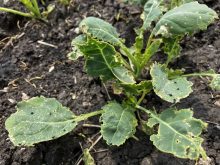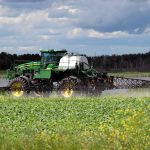Manitoba farmers have set planting records two years in a row, but this fall’s seeding could far exceed that
Manitoba farmers are getting pretty fond of winter wheat and the head of Winter Cereals Manitoba hopes the romance continues to build.
Farmers in the province grew a record 593,906 acres of winter wheat this year (double the 10-year average) and conditions are right for even more to be planted this fall, said Jake Davidson.
“I’d like to see 725,000 acres of winter wheat,” said Davidson. “There’s been a good demand for seed.”
And no wonder. This year’s winter wheat yields ranged between 50 and 100 bushels an acre, with yields in total expected to be average (65 bushels an acre) to above average, said Pam de Rocquigny, Manitoba Agriculture, Food and Rural Initiatives’ cereal specialist.
Read Also

CUSMA access key among other trade noise: Seeds Canada panel
Seeds Canada conference panelists say Canada needs to stay focused and wait as U.S. trade and tariff chaos develops, and a Canada-U.S.-Mexico Agreement review looms
This year’s winter wheat crop is also high quality, had very low fusarium head blight damage, higher-than-average protein, and was harvested early, with many fields in the central region combined before the end of July.
But the icing on the icing was strong prices, ranging from $7 to $7.50 a bushel.
And things are set up nicely for next year’s crop. Canola stubble is ideal for seeding winter wheat into and there’s plenty of that — a record 3.55 million acres of canola were grown in Manitoba this year, and much of it is already in the bin.
To qualify for crop insurance coverage, winter wheat has to be seeded into “eligible stubble” as it is less vulnerable to winterkill. Manitoba Agricultural Services Corporation (MASC) defines that as “stubble from a crop harvested in the same year that the winter wheat is seeded, with that stubble having not been disturbed by cultivation.” However, if the wheat survives the winter the corporation will insure it for the rest of the growing season.
Other qualifying stubble crops are tame hay, tall fescue seed, rapeseed, barley, wheat, oats, mixed grain, triticale, flax, mustard, fall rye, canaryseed, ryegrass seed, timothy seed, alfalfa seed, hemp grain, sunflowers, corn, borage, millet, coriander, sorghum, sudan grass or buckwheat.
The deadline for seeding winter wheat and getting full crop insurance coverage is Sept. 15. Farmers can seed until Sept. 20 but will get 20 per cent less coverage.
Anything sown later than that isn’t eligible for crop insurance, even if it survives the winter, said David Van Deynze, MASC’s manager of claim services.
Farmers should burn off weeds before seeding winter wheat and also kill any cereals growing in the field, said de Rocquigny. Living cereals can host the wheat curl mite, which can carry wheat streak mosaic that could infect the crop next year. Wheat streak mosaic is a virus and isn’t controlled with fungicides.
Even though soils are dry, de Rocquigny recommends seeding winter wheat no deeper than one inch. Seeding deeper reduces the vigour of the emerging seedling. Ideally the crop should be in the three-leaf to tillering stage by freeze-up.
Aim for a surviving plant population of 25 to 30 plants per square foot. That means taking seed germination and potential seedling mortality into account.
Farmers should also soil test to determine how much fertilizer needs to be applied. Generally 30 to 40 pounds of phosphorus are recommended at seeding time. It helps get the crop going in the fall and again in spring.
Winter wheat doesn’t need much nitrogen in the fall (which can be lost under wet conditions), but it needs it early in the spring, said MAFRI’s fertility specialist John Heard. However, wet fields can delay or prevent the application, and spring-applied nitrogen can also be lost or stranded if it’s too dry — a dilemma Agriculture Canada researcher Byron Irvin describes as being “caught between a rock and a hard place.”
His research found fall application can be effective, but during one wet year at a trial at the Brandon Research Station, fall-applied nitrogen was lost and the crop yield was cut 20 per cent.
Farmers in the Red River Valley are at the highest risk of losing fall-applied nitrogen because their fields are so often wet, Irvin said in an interview last year.
“I don’t have the data to suggest you should be using one of these protected nitrogen products there, but if I was farming there I probably would just do it because their risk of losing it is much higher than most of us (in the drier areas).”
Protected nitrogen fertilizers like ESN, Super Nitrogen and Agrotain cost more, but should be considered under higher-risk conditions, he said.



















